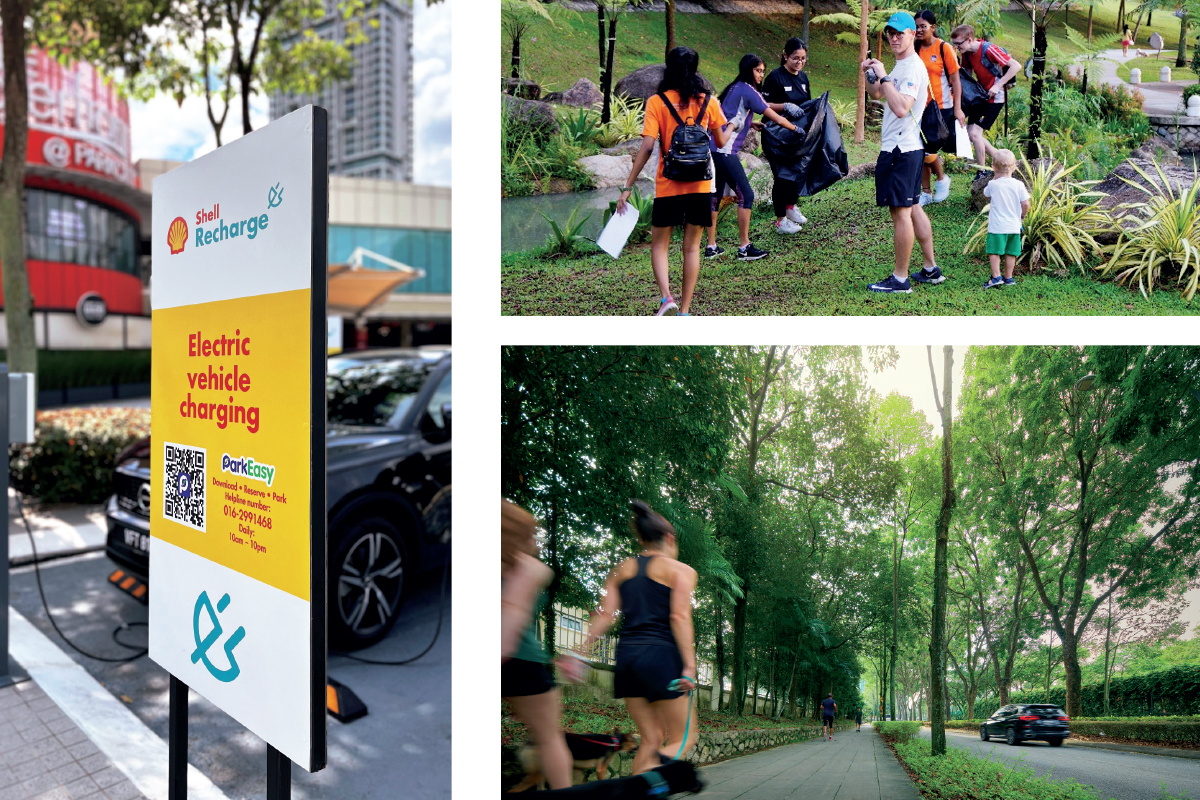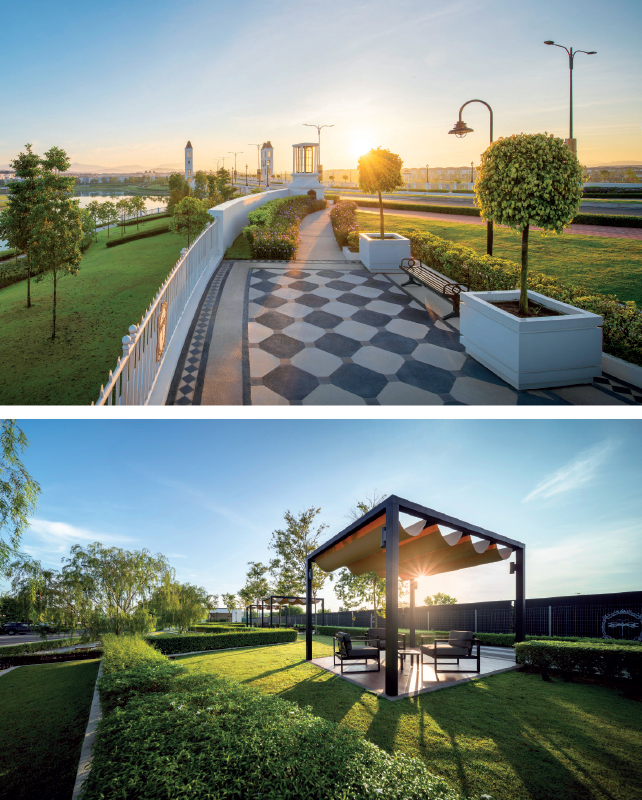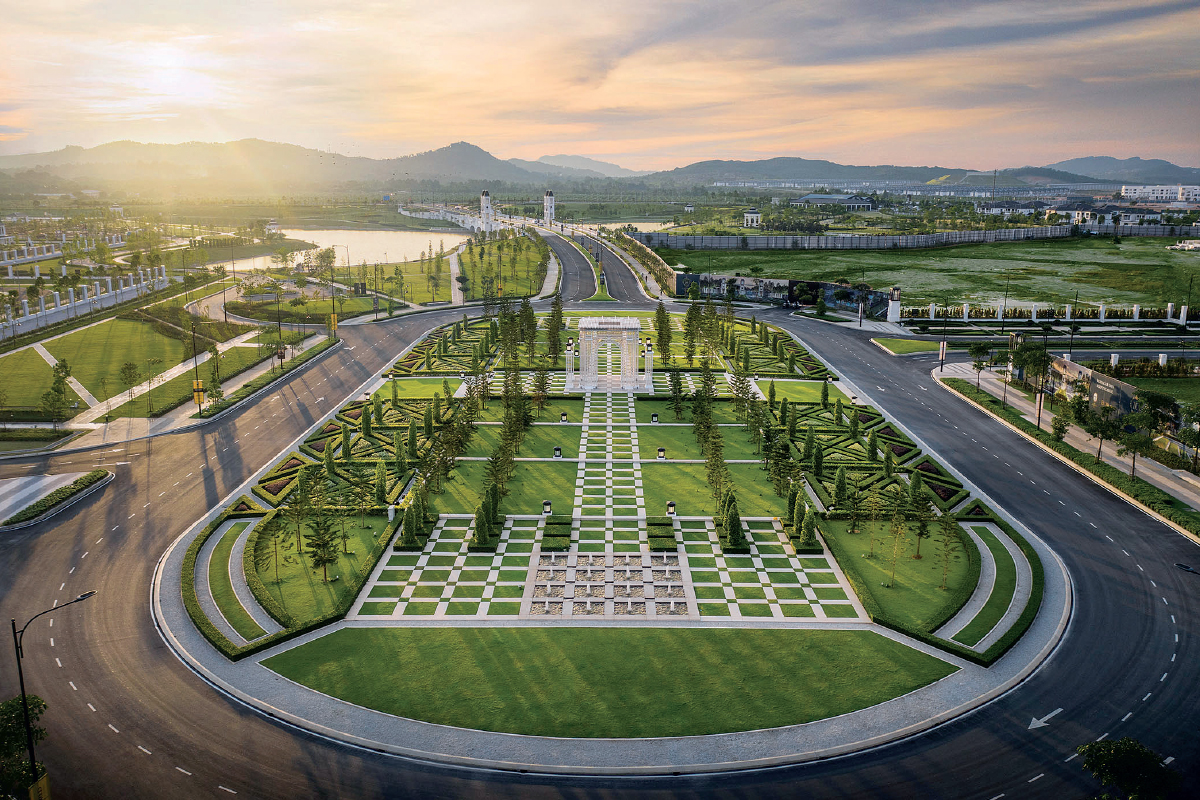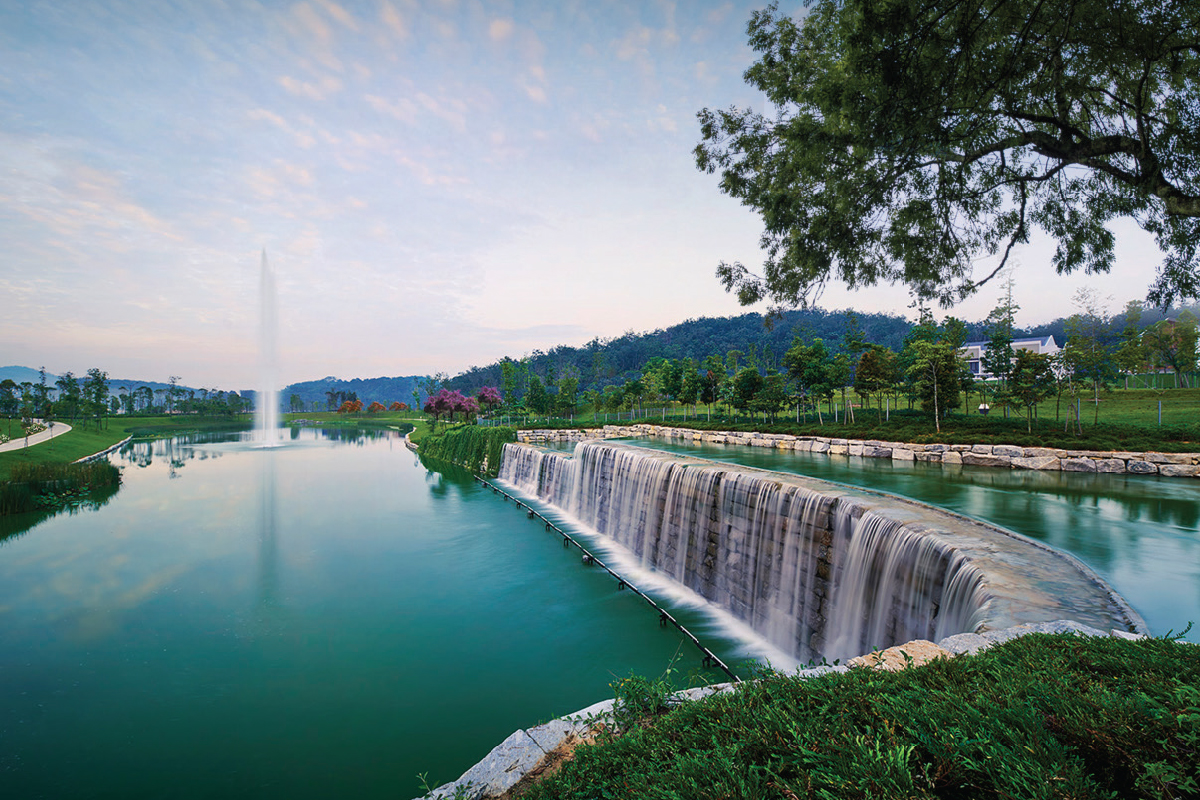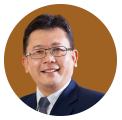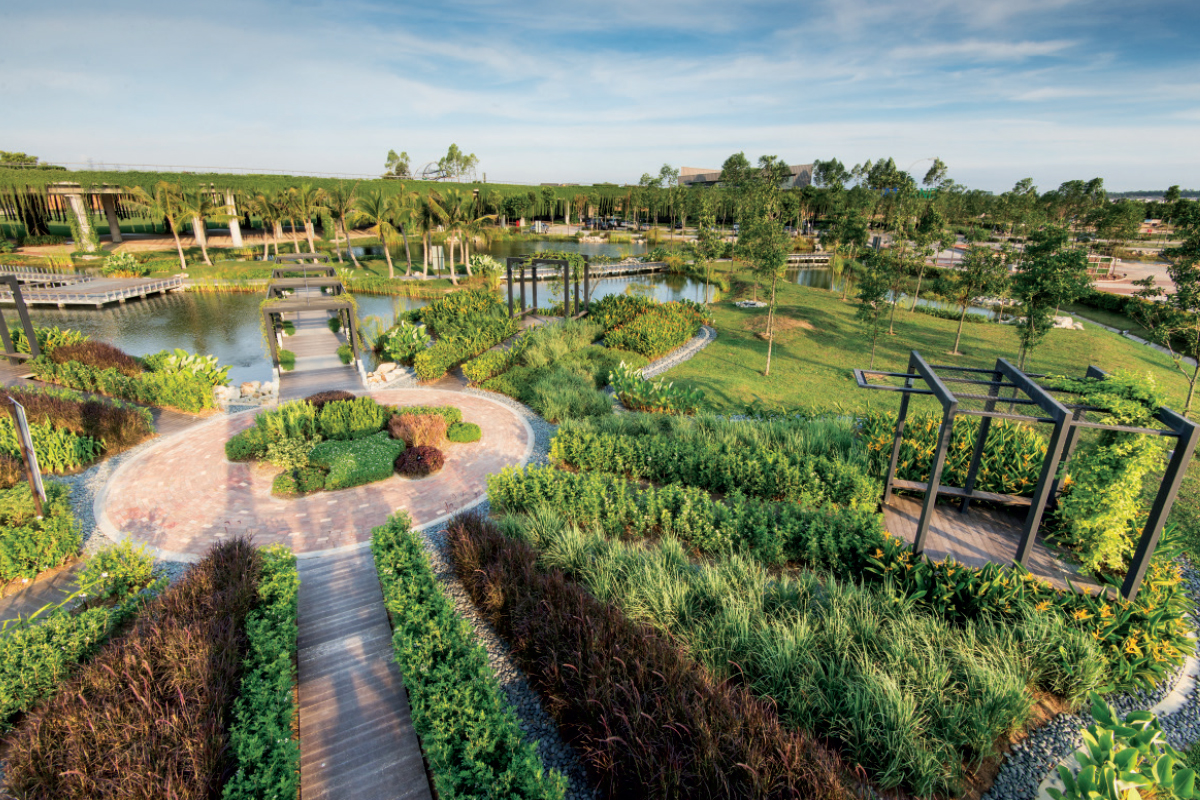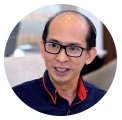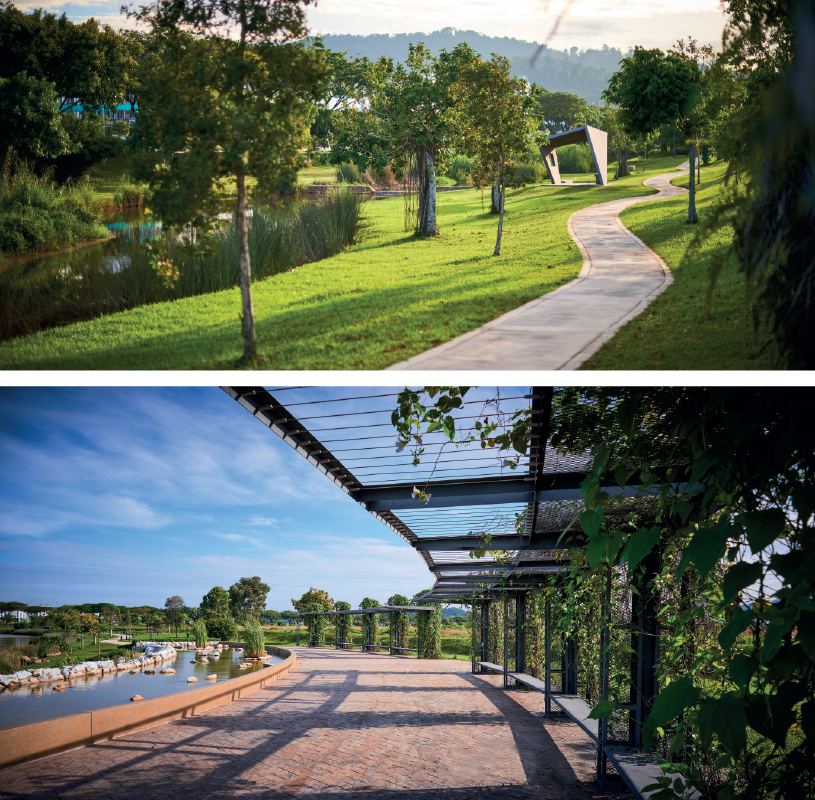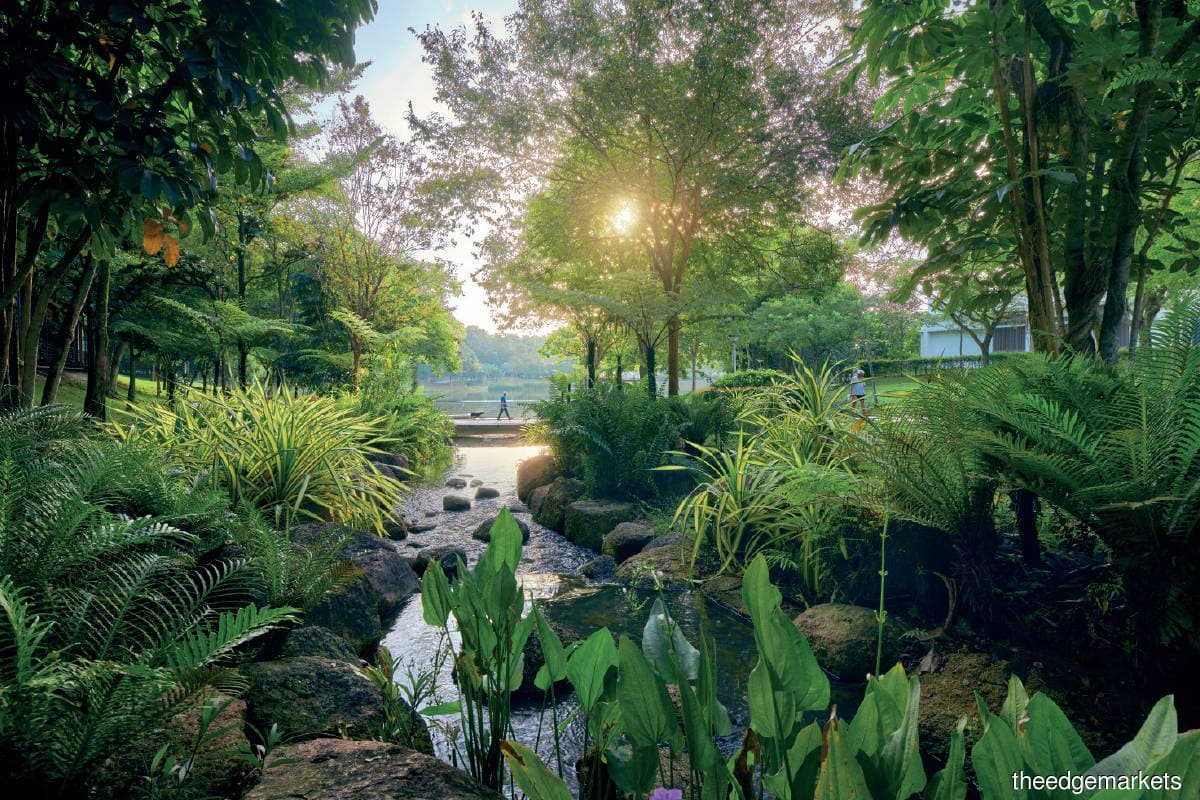
This article first appeared in City & Country, The Edge Malaysia Weekly on December 26, 2022 - January 1, 2023
Terms like “sustainability” and “green” are no longer just buzzwords but the new norm. According to Sir David Attenborough, “The scientific evidence is that if we have not taken dramatic action within the next decade, we could face irreversible damage to the natural world and the collapse of our societies. We are running out of time, but there is still hope.” We ask five developers that prioritise sustainability and being green to highlight one township development in their portfolio that best showcases their ethos. They relate how they have made the townships liveable and promote community living; the steps taken to protect the environment and preserve biodiversity; the measures to lessen the impact of the development on natural resources; and ways to ensure the sustainability and maintenance of the township.
Desa ParkCity, Kuala Lumpur|ParkCity Group
CEO Datuk Joseph Lau: At Desa ParkCity, sustainable living is more than just building a green township and landscaping. Rather, it is about curating a people-centric township based on our five pillars of family, neighbourhood, community, connectivity and convenience. While creating a liveable township is key for ParkCity Group, ensuring that the township remains liveable is even more important.
In terms of design, the township is created with amenities at its axis so residents are within walking distance of The Central Park with its large lake and The Waterfront neighbourhood mall, as well as Plaza Arkadia commercial centre, which offers myriad F&B options and other conveniences.
There is also a local school, an international school, a medical centre and a recreation club, as well as the upcoming ParkCity Town Centre.
We continue to prioritise community engagement through activities that promote community living and volunteerism, among others.
We have also kept Desa ParkCity as natural as possible by having a lot of forest species and vast green spaces, which are a distinctive feature in our healthy and liveable community.
Besides encouraging community building, the township’s central park and its lake also foster a local ecosystem that reduces heat islands, and provides an ideal habitat for a diverse range of flora and fauna. More than that, the lake also acts as a retention pond to facilitate stormwater discharge, storing and reusing rainwater through two centralised lakes within the township.
Trees for the township are carefully selected to ensure that they thrive with minimal maintenance. Choosing the “right plant for the right place” is a key consideration in our development. The flowers, fruits and leaves of some of the trees also provide food for some native birds and butterflies.
In 2014, a softscape nursery was created to cater to the township’s needs. We also conserve or transplant the existing trees during construction. Tree taxonomy tags have been introduced to provide a basic understanding and educate the public about tree species.
Having a sustainable lake design with a biofiltration system is among the measures to lessen the impact on natural resources. The Central Park Lake is a man-made lake built to complement The Central Park and act as a key player in our township’s stormwater management system. To protect the lake water from bio-waste contamination, two biofiltration systems have been installed to regulate the lake water. This technology has greatly helped to reduce manpower and other resources for maintaining and cleaning the lake. The lake is a healthy ecosystem of native fishes and aquatic plants that clean the lake and provide healthy nitrate levels that keep the biofiltration mechanism sustainable.
ParkCity’s in-house township and landscape department has also succeeded in creating our own mix-soil treatment and planting technique after numerous tests. We did this as we faced challenges with healthy tree growth due to the extensive subsoiling and topsoiling works that had been done on the site.
We are installing more electric vehicle (EV) charging stations in commercial areas as well as in all strata developments moving forward. At our recently launched Noora development, for example, we have allocated 20% of the car park bays for EV charging.
We adopt the “15-minute city” urban design approach at Desa ParkCity to promote human mobility, improve the quality of life and reduce the carbon footprint, whereby The Waterfront and Plaza Arkadia are within a 15-minute walk or 400m radius of the township’s residents.
We also hold campaigns regularly to build public awareness on environmental issues. Some of our past events include World Environment Day, recycling programmes, gotong royong/Plalking, Farmers Market at The Waterfront, Earth Hour and DIY Project — Grow your own edible garden.
We believe sustainability and maintenance of the township are achieved by engaging and working hand-in-hand with the residents through the respective management corporations (MCs) and joint management bodies (JMBs) to promote a strong sense of belonging in the township. For example, Plalking, or picking litter while walking, events are held as community initiatives to keep the township clean while building the community, while pet dispensers are strategically placed to instil responsibility in both resident and visiting pet owners to keep the park clean.
To ensure security and safety, ParkCity also works closely with the local police, in addition to having our own auxiliary police and security teams. Each project within the township is also designed to be gated and guarded with perimeter fencing, individual guardhouses and a single ingress and egress point. According to our statistics, Desa ParkCity has one of the lowest crime rates within the Klang Valley.
Eco Grandeur, Selangor | Eco World Development Group Bhd
Deputy CEO Liew Tian Xiong: Sustainability is at the heart of Eco World Development Group Bhd’s (EcoWorld) vision of “Creating Tomorrow & Beyond” and it is the core value of the EcoWorld brand.
We are deeply committed to preserving and enhancing the value of our development lands through meticulous master planning, which ensures that natural ecosystems continue to thrive in harmony with the built environments created.
Apart from environmental considerations, as part of our development ethos, we also prioritise the liveability of our townships and consciously co-create places and spaces that foster economic and business growth to improve livelihoods and are mindful of our social responsibility towards the broader community.
Our largest township, Eco Grandeur in Puncak Alam, provides the best example of EcoWorld’s development philosophy and how our master planning takes into account biodiversity preservation and enrichment along with the manner in which it is implemented and executed on the ground.
In 2016, we purchased the land for Eco Grandeur and spent the next two years doing site assessments and rolling out biodiversity studies and strategies, whereby we engaged many specialists such as geological engineers, ecologists and environmental consultants to research, study, analyse and summarise existing land conditions physically and biologically.
By incorporating biodiversity studies at the inception of the development, we are able to understand the existing ecosystems and how they can be further enhanced as well as ensure that we plant the correct species of plants and trees for the local flora and fauna to thrive.
This includes the careful selection of species for landscaping as well as transplanting trees where possible. Carbon capture studies have also been conducted to discern which species of trees are better for absorbing carbon under what conditions, as we have discovered that some types will do better in different settings whether due to soil, sun or other factors.
We are most proud of the township’s 62-acre Dragonfly Park, which makes Eco Grandeur an ecological “stepping stone” for native bird communities to feed and rest while traversing between the Selangor coast and the Titiwangsa mountain range. The landscaping of parks and gardens were designed to host a wide range of biodiversity to regenerate a balanced food chain. In addition to this, the parks and lakes serve as focal points in the township for recreational activities, and the health and wellbeing development of the community.
Where possible, we have also salvaged and replanted trees and have collaborated with FRIM (Forest Research Institute Malaysia) to harvest and replant healthy trees. Furthermore, we have also set a key performance indicator that 15% of our development lands are to be dedicated to green spaces, which is more than the regulatory requirement.
To minimise waste and pollution caused by the cut and fill process, developments were designed to follow the natural shape of the landscape, including the preservation of the natural topography and water bodies. This allows the landscape to maintain its natural drainage patterns and native vegetation. Such water bodies also act as a natural border between the residential and commercial areas, and encourage the growth of local flora and fauna. Aquatic plants provide bio-filters, erosion control, and a habitat for aquatic life. The use of natural drainage patterns, with the implementation of new detention ponds as required, provides flood mitigation.
Our sustainable procurement policy informs our business partners, including suppliers, vendors and contractors, to adopt or find alternatives for practices, products and materials that are least harmful to nature. Where feasible, preference is given to those that offer services and products that are designed, sourced and manufactured taking into consideration the impact on the environment.
EcoWorld is also ISO 14001:2015 Environmental Management System certified, which outlines the approach on how we should operate without causing further harmful impact to the surrounding environment on the land we are developing.
To ensure that Eco Grandeur remains beautiful and loved by generations to come, we believe that education plays a very important role in preserving our efforts. The team at Eco Grandeur has set up a “green wall” at its sales gallery to share with our local community the township’s environmental journey since 2017. This includes the biodiversity educational ribbon that is being implemented and continually enhanced as the development progresses to harmonise the built environment with nature. Educational trails — the first 2km trail is scheduled to be completed by end-2023 — are being developed to spread awareness and enhance residents’ and visitors’ understanding of the importance of biodiversity.
Gamuda Gardens, Selangor|Gamuda Land
Executive director of product management unit Jess Teng: With strong fundamentals in good master-plan design as well as mindful creation of innovative products over the years, Gamuda Land has positioned itself as a trusted brand in delivering value to our stakeholders.
“[The philosophy] when we get the places right, the town works” has kept our team on their toes, to constantly look at a master-plan design that works for each township. As each of our townships has its own unique personality and land profile, we are careful to incorporate the right mix of components [that enable each development to complement its surrounding environment].
At Gamuda Gardens, before we delivered any residential precinct, we completed our 50-acre central park featuring five cascading lakes, two waterfalls and ample community gathering places as well as commercial component Waterfront Village, which have now become a popular destination for the surrounding community. We activated the park with various activities such as horse-riding, solar express train rides, a carousel and donut boat rides. Sports facilities at Gardens Wellness and the Fifa-standard Gardens Arena football pitch are also ready to keep the community healthy.
We have also launched Gardens Square, which is anticipated to be a lifestyle retail hub for northern Klang Valley. This will be completed by end-2023, in line with the opening of the exhilarating wheeled-gravity ride, Luge Activity Park, at the township.
We also have a nature school programme by Gamuda Parks to nurture young minds to explore the environment through a series of well-curated outdoor learning programmes at Gamuda Gardens. Participants will be guided through the forest trail for a better understanding of the ecosystem as a whole.
We remain grounded on our development principle of “listening to what the land has to tell us” and Gamuda Gardens is a success story of holistic rehabilitation and regeneration where we build with respect for nature. Formerly an abandoned monoculture rubber plantation that lacked diverse flora and fauna, it has been transformed into a thriving and bio-diverse ecosystem.
In 2018, we became the first developer, and we remain the only developer in Malaysia to date, to officially commit to conducting scientific biodiversity audits in our towns through Gamuda Parks — bringing together non-governmental organisations and experts as well as consultants who work with flora and fauna, to improve the designs and maintenance of the parks in Gamuda Land’s new townships.
We started by planting more than 8,000 trees at the central park with 77% of native species while 23% of the species are classified as having conservation importance. At least 22 species are at high risk of global extinction.
We use the Miyawaki planting method so our trees can grow 10 times faster and 30 times more dense than usual to create an urban forest. By doing this, we have begun to see the return of fauna, including migratory birds, butterflies and dragonflies. To protect them, we have planted fruit trees, created a pollinators’ garden and ensured the availability of perches to attract birds to our developments.
Our objective is to create an environment that is healthy and conducive for people and nature. We have conducted three biodiversity audits in Gamuda Gardens and the findings have shown a 16% increase in bird species on top of the native plant species that we have planted.
Rehabilitating a monoculture plantation was no easy feat, as the land came with several underlying legacy issues, such as the lack of plant varieties to provide nutrients to the soil, and the lack of ground cover to protect against erosion.
Following a site analysis, our main strategies were to preserve the main green gully and undulating terrain, create streaming lakes and waterways, and lay out a green network to the central park before establishing residential parcels overlooking the green lung.
With this approach, we purposefully incorporated designs that took full advantage of, and were aligned with, the natural contours of the landscape, ensuring they did not radically alter the natural surroundings — avoiding conventional earthwork activities that typically involves major cutting.
We have also transplanted some native tree species, while topsoil has been harvested for future use in the development. As plants generally concentrate their roots in and obtain most of their vital nutrients from the topsoil layer, this practice of topsoil reuse is richly beneficial for subsequent tree planting and helps nurture ecosystems in and around communities.
In line with the Gamuda Green Plan 2025, through which we are committed to reducing our emissions intensity by 45% by 2030, we have put in place some key strategies.
Besides landscaping, biodiversity enrichment programmes and Gamuda Land’s target to nurture one million trees across our townships by 2023, our efforts include adoption of renewable energy wherever we can.
At Gamuda Gardens, the rooftop of our Waterfront Village has been installed with solar photovoltaic panels with a capacity of 310kWp, which are used to offset electricity consumption at the sales gallery and common areas. Plans are also underway to add another 310kWp within the township by July 2023.
In terms of green transport mobility plans for the development of a low-carbon transport ecosystem within our townships, we have installed EV charging stations and also partnered with Tenaga Nasional Bhd to develop Malaysia’s first electron stations at Gamuda Gardens (as well as Gamuda Cove).
Gamuda Gardens also has a 68km dedicated cycling pathway in an effort to promote the usage of non-motorised vehicles to reduce our carbon footprint.
IJM Rimbayu, Selangor|IJM Land Bhd
Senior general manager for central region (Seremban 2 and IJM Rimbayu) Chai Kian Soon: In conceptualising IJM Rimbayu to offer holistic living, our aim was to transcend architectural excellence to provide an environmentally friendly, safe and community-engaging ecosystem.
The master plan is the result of a vision to create a safe and sustainable community that embraces the idea of urban living with walkable, tree-lined streets, neighbourhood town centres, offices in the parks, schools and abundant public places and amenities.
The Green Building Index (GBI)-certified township development spans 1,879 acres within the district of Kuala Langat. Its identity as a green township is expressed via the numerous environmentally conscious features and characteristics.
Key features include generous recreational areas that exceed the minimum requirements for open spaces, with each phase in the township having its own recreational park with large open spaces suitable for community get-togethers and activities. A generous portion of the total development has been allocated for nature. These include green linkages, pocket parks with amenities such as cycling tracks and jogging paths, and extensive greenery to mitigate heat build-up in public spaces and provide a cooler environment. There are also pockets of green connectors linking one neighbourhood to another, encouraging more outdoor community-bonding activities; man-made creeks and canals; and recycling elements.
As for the homes, they are built with sustainability features — solar panel water heater systems to reduce consumption of electricity; rainwater harvesting system for landscape irrigation and to reduce outdoor water consumption and help reduce surface runoff to the existing drains; use of low volatile organic compound (VOC) paint to reduce hazardous air toxins for the wellbeing of occupants; water-efficient sanitary fittings to decrease water consumption; Sisalation roofs designed for better ventilation to reduce the “heat island” effect; natural lighting and ventilation features to cut down on the use of lights and air-conditioning; and a north-south orientation for most homes to cut down on direct sunlight and heat transmission into the building’s internal spaces.
IJM Rimbayu obtained an Environmental Impact Assessment report that was cleared prior to the development, whereby suitable measures were identified to reduce our environmental impact for both on-site and the immediate surroundings.
We have also set a target to achieve a minimum bronze GreenRE certification for future developments.
The township is also home to The ARC, the township’s 16-acre landmark, which incorporates the concept of “Embracing life within nature” and boasts a green canopy with a 360°panoramic view of the township. The ARC has one of the largest rainwater harvesting systems in Malaysia, in which rainwater is routed into canal waterways and channelled through drips on each column where climbing plants are grown, discharged into the creek and recycled for irrigation purposes. The result of this nature-inspired design is that no treated water has been used for irrigation over the past nine years.
The ARC also serves as a social hub and sustainable centrepiece, drawing members of the community to its 10,000 sq m elevated green deck, football field, herb/flower garden and green walls with over 50,000 trees, herbs and flowering plants, as well as clubhouse.
IJM Land has planted a total of 21,000 trees in the township. This lush planting allows natural shading, creating a serene environment. In addition, mature trees are conserved or transplanted whenever possible. To ensure the sustainability of the neighbourhood’s green spaces, we commit a sum of RM170,000 per month to maintain the landscape and grounds in the township.
We have adopted measures to reduce our dependence on municipal-supplied water. A series of water bodies has been built within the township as water retention for cleaning, recreational use and landscaping purposes as well as to overcome the flood situation during rainy seasons. The water bodies require minimal earthwork in maintaining the water quality.
To reaffirm our commitment to green environments, last year, IJM Rimbayu installed 750 solar panels on the rooftop of The Gallerie and The Club to generate renewable energy. Energy generated from these panels supplement the power used for its sales gallery and project office. This initiative will generate an estimated 91.4% savings on energy for the centre, making it close to being self-sustainable. We will continue to invest in innovative technologies, as well as energy and water efficiency measures for our project developments and to safeguard the environment where possible.
IJM Land continues to be certified with the ISO 14001:2015 Environmental Management System and set targets to achieve greater and greener goals.
Setia Alam, Shah Alam|S P Setia Bhd
Divisional general manager Tan Siow Chung: Setia Alam, S P Setia’s 2,525-acre flagship township in Shah Alam, has been master planned in line with our LiveLearnWorkPlay development philosophy where homes and amenities are curated to meet the lifestyle needs of our communities within a self-sustaining township.
To encourage community living, the township has six large parks — Wetland Park, Urban Park, Setia City Park, Town Park, Western Park and the upcoming Active Park, which will be completed in 2023. Setia Alam’s parks and pocket gardens make up 400 acres of its green area and are equipped with recreational facilities such as jogging tracks, playgrounds and cycling tracks that are accessible by the public and encourage residents to spend time outdoors.
The parks in Setia Alam have retention lakes and ponds that hold surface runoff rainwater during heavy downpours. Engineered waterways have also been created around the township to act as natural security barriers.
The Setia Alam Club offers fitness facilities such as badminton courts, adults’ and children’s swimming pools and a gymnasium to promote a healthier lifestyle.
The township’s vibrancy is enhanced by commercial hubs, namely Setia Taipan I and Setia Taipan II, as well as its largest neighbourhood mall Setia City Mall, which not only provide residents with a wide variety of dining and shopping options, but also boost business opportunities within Setia Alam. Moreover, Setia City Park and Setia City Convention Centre provide spacious venues for large-scale events.
In addition, Setia HC Ventures Sdn Bhd, a subsidiary of S P Setia, has partnered with Qualitas Medical Group to provide an Ambulatory Care Centre at the high-rise Setia City Residences. The centre will offer comprehensive specialist and surgical services in the areas of wellness, diagnosis, treatment and rehabilitation.
In terms of preserving the environment and biodiversity, Setia Alam has the ideal landscape for birds. The Wetland Park attracts migratory birds during the months of November and December.
In 2022, several measures were taken to cultivate the biodiversity in the township. Four adult ducks, 10 ducklings, a couple of geese and 10 Geopelia birds (burung merbok), were released at the Wetland Island.
To prevent the breeding of mosquitoes in the waters of Setia Alam, 200 tropical fish were released at the Wetland Park, the engineered waterways around the township and the ponds at the parks. To attract more pollinators like butterflies and bees, nectar-rich flowering plants were planted along the waterways of the Wetland Park. We planted trees that act as shelter for birds to nest and breed, and created a fish habitat to protect the fishes from predators and strong currents.
To reduce our carbon footprint, we have several renewable energy solution initiatives. For instance, Setia City Convention Centre is equipped with EV charging stations, and streetlights around the township and its parks are solar powered.
Furthermore, Setia Alam’s most recent implementation will be the “green switch”, which will be installed in 120 double-storey terraced houses of the upcoming Musika Homes Phase 2A project. The “green switch” will allow residents to reduce energy consumption by switching off all non-essential appliances with just one switch. In addition, each home will also be readied with solar panels with capacity of 2.25 kWp on the rooftops, helping residents to reduce domestic carbon emissions on a daily basis.
To improve air quality in the homes, Setia Alam is partnering Panasonic Malaysia to provide a sustainable air management solution using the latest Complete Air Management System (CAMS) in the upcoming Phase 2A of Musika Homes. CAMS purifies the air using artificial intelligence and cloud-based technologies that detect and control indoor air conditions by adjusting the temperature, humidity, air filter of PM2.5 and carbon dioxide levels.
The township also has a recycling hub that is supported by the residents’ association to spread awareness on recycling responsibly.
Additionally, the project management team at Setia Alam continuously upgrades the infrastructure of public facilities and parks to ensure a comfortable and safe environment for all.
Moreover, Setia Alam homes are built sustainably with carefully sourced construction materials that are environmentally friendly and more durable so that less maintenance work is required.
Save by subscribing to us for your print and/or digital copy.
P/S: The Edge is also available on Apple's App Store and Android's Google Play.


